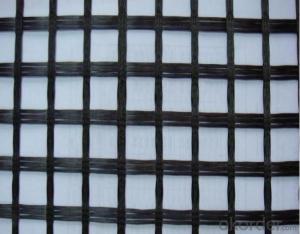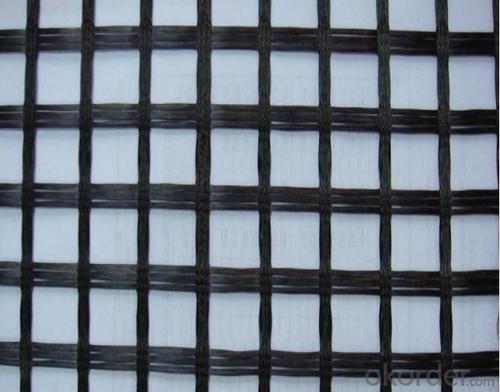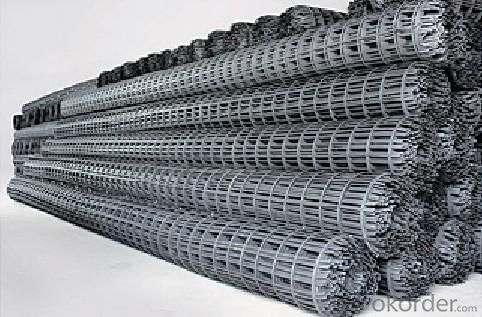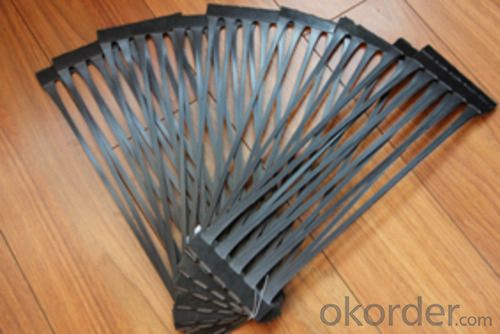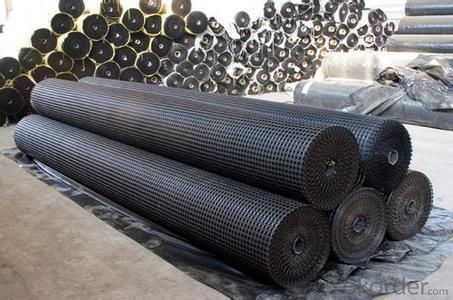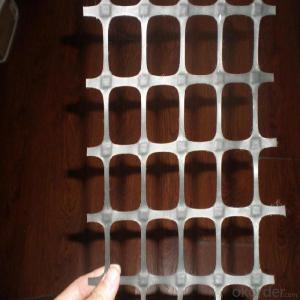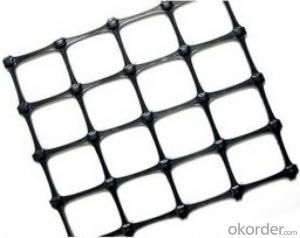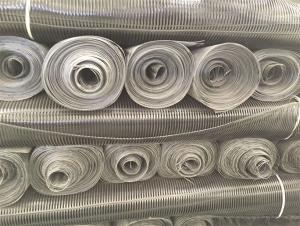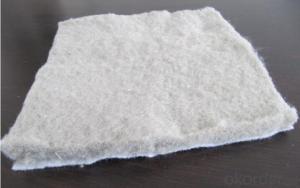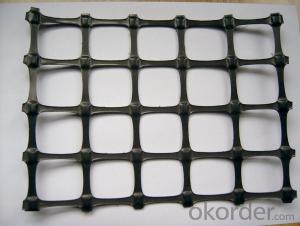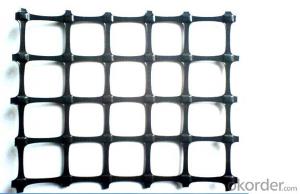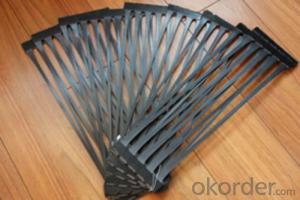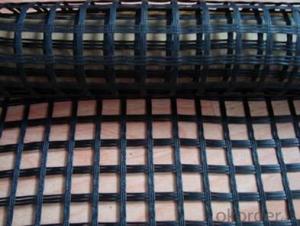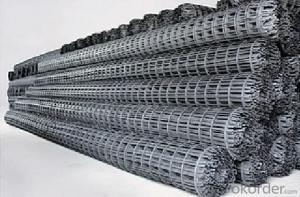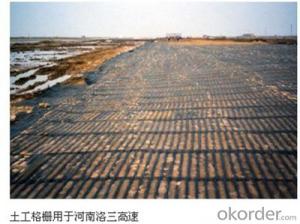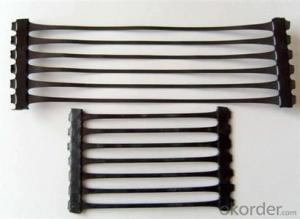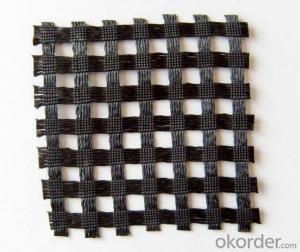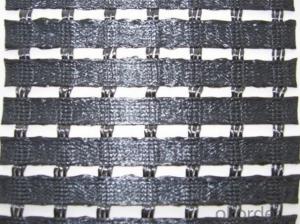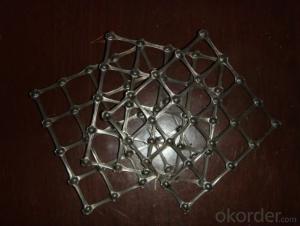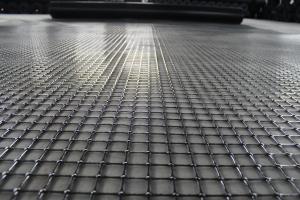Geo Cells and Geogrids - Plastic Soil Stabilization Geogrid with CE Certificate
- Loading Port:
- Qingdao
- Payment Terms:
- TT OR LC
- Min Order Qty:
- 30000 g/m²
- Supply Capability:
- 600000 g/m²/month
OKorder Service Pledge
OKorder Financial Service
You Might Also Like
Structure of Plastic Soil Stabilization Geogrid Description:
The warp knitted polyester geogrid has the characteristics of high intension,low elongational ration,erosion-resistant,aging-resistant,high occlusive force with soil or gravel,light weight,water drainage and so on.
Main Features of Plastic Soil Stabilization Geogrid:
1) Roadbed reinforcement of road and railway,crack prevention,increase of roadbed strength;
2) Reinforcement and stabilization of riverside,embankment and side slope;
3) Dyke reinforcement on soft ground for stress evenness,sedimentation adjustment,increase of and loading capacity of fundus;
4) Reinforcement of the surface of road and bridge.
Plastic Soil Stabilization Geogrid Images
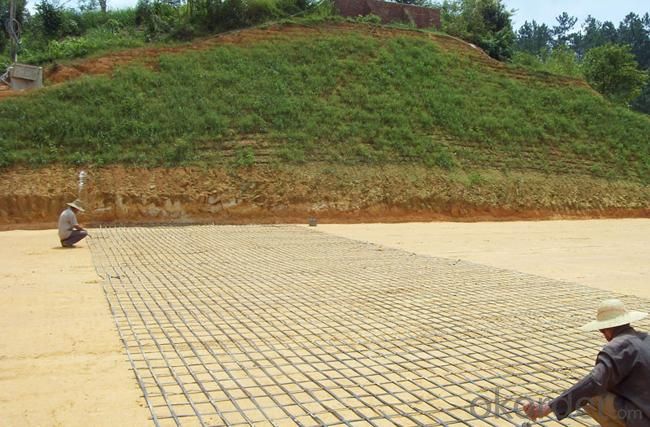
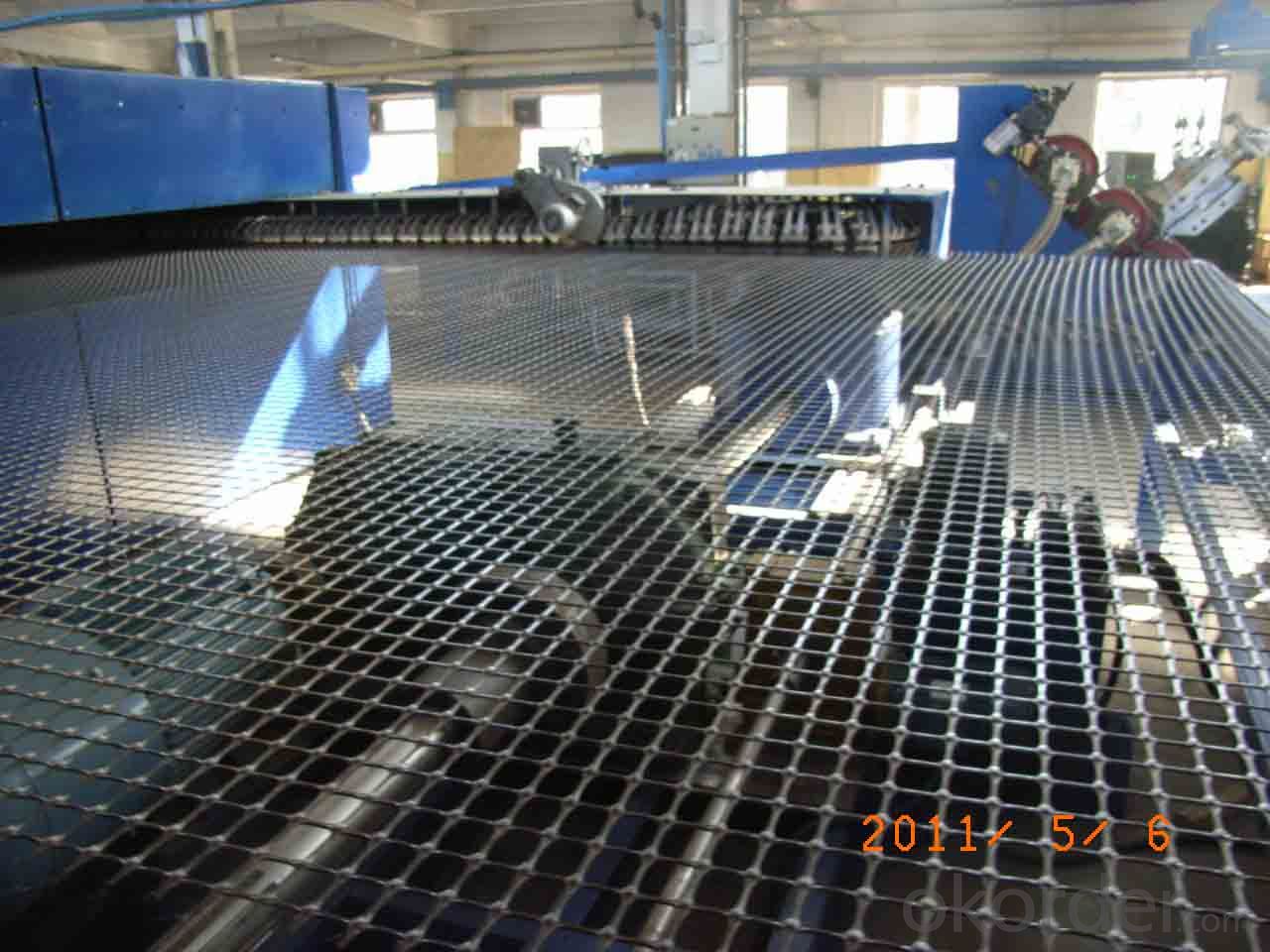
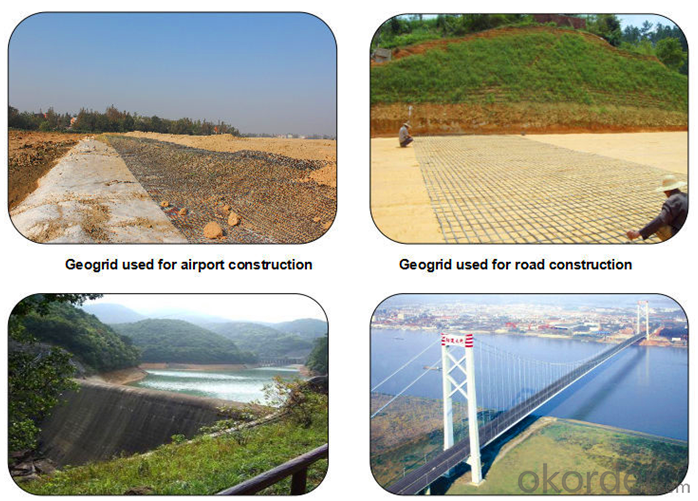
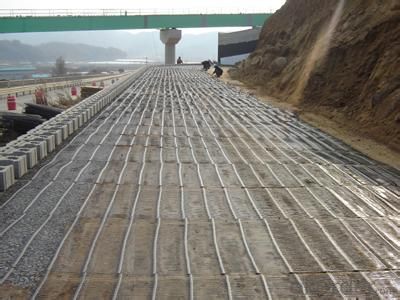
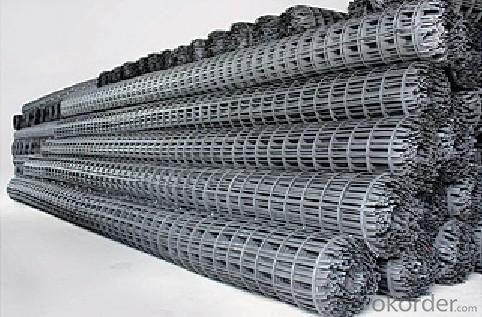
Plastic Soil Stabilization Geogrid Specification:
| performance/specification | PET-20-20 | PET-30-30 | PET-40-40 | PET-50-50 | PET-80-80 | PET100-100 | |
| Stretching ratio % | 13% | ||||||
| intensity KN/m | Vertical | 20 | 30 | 40 | 50 | 80 | 100 |
| Horizontal | 20 | 30 | 40 | 50 | 80 | 100 | |
| Center distance of the network mm | 12.7X12.7 25.4X25.4 40X40 | ||||||
| Breadth m | 1--6 | 1--6 | 1--6 | 1--6 | 1--6 | 1--6 | |
| performance/specification | PET-50-30 | PET-60-30 | PET-80-30 | PET-80-50 | PET100-50 | PET120-30 | ||
| Stretching ratio % | 13% | |||||||
| intensity KN/m | Vertical | 50 | 60 | 80 | 80 | 100 | 120 | |
| Horizontal | 30 | 30 | 30 | 50 | 50 | 30 | ||
| Center distance of the network mm | 12.7X12.7 25.4X25.4 40X40 | |||||||
| Breadth m | 1--6 | 1--6 | 1--6 | 1--6 | 1--6 | 1-6 | ||
FAQ
We have organized several common questions for our clients,may help you sincerely:
Q1: How about your company?
A1:Our company are one of the largest geosynthetic products supplier in the world.We have the products experience more than 20 years.Already export to USA/Germeny/Australia/Zambia/Brazil etc.more than 20 countries.Almost 10years.Our products including Geocell/Fiberglass Geogrid/Geomembrane/Geotextile/Geonet etc.
Q2.Does your products have good qualitity?
A2:Yes,we have do many big projects such as the 2008 Beijing Olympic BIRD NEST. Divert water from the south to the north project. And our products have CE certificate also.
Q3:How long can we receive the products after purchase?
A3:In the purchase of product within three working days, We will arrange the factory delivery as soon as possible. The pecific time of receiving is related to the state and position of customers.Commonly 15-20 working days can be delivery.
- Q: Can geogrids be used for reinforcement in railway track construction?
- Yes, geogrids can be used for reinforcement in railway track construction. Geogrids provide improved stability, increased load-bearing capacity, and enhanced resistance against deformation in the track structure. They can effectively distribute the load across the track, reducing the risk of settlement and track deformation. Additionally, geogrids offer long-term durability, making them suitable for railway applications.
- Q: Are geogrids suitable for reinforcing bridge abutment backfills?
- Yes, geogrids are suitable for reinforcing bridge abutment backfills. Geogrids provide increased stability and load-bearing capacity to the soil, preventing erosion and settlement. They distribute the load evenly, reducing the risk of structural damage to the bridge abutment. Additionally, geogrids improve the long-term performance and durability of the backfill materials.
- Q: Geotextiles for geotextiles - Specification for geotextiles
- Zhang Hai, a manufacturer of geotextiles, answers to the question, geotextile, also known as geotextile, which is made of synthetic fibres by means of acupuncture or weaving. Finished cloth, the general width of 4-6 meters, the length of 50-100 meters. Geotextiles are divided into spun geotextile and nonwoven geotextile. Geotextile has excellent filtration, drainage, isolation, reinforcement, seepage prevention, protection, light weight, high tensile strength, good permeability, high temperature resistance, anti freezing, anti-aging, corrosion resistance. A non-woven cloth is made of filament or staple through the equipment and technology of different laying into the mesh, after acupuncture process for different fiber intertwined intertwined fixing fabric specification, make the fabric soft, plump, thick, stiff, to achieve different thickness to meet the use requirements, non-woven geotextile fabric has good clearance, good adhesion, because the fiber is soft with tear film can be
- Q: Can geogrids be used in temporary construction access roads?
- Yes, geogrids can be used in temporary construction access roads. Geogrids are commonly used to reinforce and stabilize soil, making them an ideal solution for temporary roads that need to withstand heavy equipment and frequent use during construction projects.
- Q: How do geogrids enhance the stability of landfill slopes?
- Geogrids enhance the stability of landfill slopes by providing reinforcement and increasing the strength of the soil. They are placed within the soil layers of the slope to distribute the applied loads and prevent excessive deformation. The geogrids act as a tension element, spreading the load across a wider area and reducing the risk of slope failure. Additionally, they improve the overall stability of the landfill slopes by controlling soil erosion, promoting drainage, and minimizing the potential for lateral movement.
- Q: What are the typical applications of geogrids?
- Geogrids are commonly used in civil engineering and construction projects for various applications such as soil stabilization, reinforcement of retaining walls, slope stabilization, pavement reinforcement, and erosion control. These grids provide strength and stability to soils, reducing the chances of soil movement and improving the overall stability and longevity of the structure.
- Q: What is the effect of creep on geogrid performance?
- Creep can have a significant impact on the performance of geogrids. Over time, the constant stress and strain on the geogrid can cause it to slowly deform and lose its original shape and strength. This can result in reduced load-bearing capacity and overall effectiveness of the geogrid in reinforcing and stabilizing the soil. It is important to consider creep behavior when designing and selecting geogrids for long-term applications to ensure their durability and performance.
- Q: Do geogrids increase the bearing capacity of soil?
- Yes, geogrids can increase the bearing capacity of soil. Geogrids are geosynthetic materials that are used to reinforce soil and improve its stability. By distributing the load more evenly, geogrids can enhance the load-bearing capacity of the soil, making it more suitable for construction or other heavy-duty applications.
- Q: Can geogrids be used in coastal protection structures?
- Yes, geogrids can be used in coastal protection structures. Geogrids are often employed in coastal engineering projects to reinforce soil and prevent erosion. They provide stability and strength to various coastal structures such as seawalls, revetments, and breakwaters, helping to mitigate the impact of waves, tides, and currents.
- Q: What is the effect of confinement on geogrid performance?
- The effect of confinement on geogrid performance is generally positive. Confinement helps improve the stability and load-bearing capacity of geogrids by restraining lateral movement and enhancing soil-geogrid interaction. It prevents the geogrid from elongating or deforming under heavy loads, leading to better reinforcement and increased structural integrity. Confinement also reduces the potential for geogrids to slip or creep, improving their long-term performance and durability.
Send your message to us
Geo Cells and Geogrids - Plastic Soil Stabilization Geogrid with CE Certificate
- Loading Port:
- Qingdao
- Payment Terms:
- TT OR LC
- Min Order Qty:
- 30000 g/m²
- Supply Capability:
- 600000 g/m²/month
OKorder Service Pledge
OKorder Financial Service
Similar products
Hot products
Hot Searches
Related keywords
